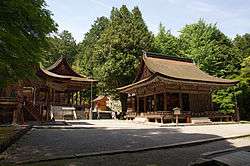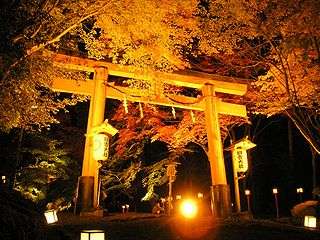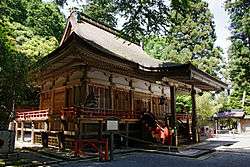Hiyoshi Taisha
| Hiyoshi Shrine (日吉大社 Hiyoshi taisha) | |
|---|---|
|
Nishi Hongū (West Hall of Worship) Honden | |
| Information | |
| Address | Ōtsu, Shiga Prefecture, Japan. |
|
| |

Hiyoshi Taisha shrine (日吉大社, the same characters used to be pronounced Hie Taisha) is a Shinto shrine located in Ōtsu, Shiga, Japan. This shrine is one of the Twenty-Two Shrines. Hiyoshi Shrine (日吉大社 Hiyoshi taisha), also known as Hiyoshi jinja (日吉神社) or Hie jinja.
The West Hall of Worship (西本宮, nishi hon-gū) and the East Hall of Worship (東本宮, higashi hon-gū) have been designated by the Agency for Cultural Affairs as National Treasures in the category shrines.[1] This shrine heads the seventh largest shrine network in Japan, at about 4,000 shrines.
Enshrined gods
- Ōnamuchi
- Ōyamakui
History
Hiyoshi Taisha was first recorded in Kojiki, written in the 8th century. In the Middle Ages, the Enryaku-ji temple influenced the shrine to include some Buddhist essence.
The buildings of the shrine were burnt when Oda Nobunaga destroyed Enryaku-ji in 1571. The existing buildings were constructed in the last quarter of the 16th century.
The shrine became the object of Imperial patronage during the early Heian period.[2] In 965, Emperor Murakami ordered that Imperial messengers were sent to report important events to the guardian kami of Japan. These heihaku were initially presented to 16 shrines;[3] and in 991, Emperor Ichijō added three more shrines to Murakami's list. Three years later in 994, Ichijō refined the scope of that composite list by adding Umenomiya Shrine and Gion Shrine, which is now known as Yasaka Jinja.[4]
In 1039, Emperor Go-Suzaku ordered that one more shrine be added to the grouping created by Murakami and Ichijō—the Hie jinja. This unique number of Imperial-designated shrines has not been altered since that time.[4]
From 1871 through 1946, the Hie jinja was officially designated one of the Kanpei-taisha (官幣大社), meaning that it stood in the first rank of government supported shrines.[5]
Gallery
 Usagu
Usagu Shirayamahime-jinja
Shirayamahime-jinja Hiyoshi Toshogu
Hiyoshi Toshogu
| Wikimedia Commons has media related to Hiyoshi Taisha. |
See also
References
- ↑ The Agency for Cultural Affairs (2008-11-01). 国指定文化財 データベース (in Japanese). Database of National Cultural Properties. Retrieved 2009-12-15.
- ↑ Breen, John et al. (2000). Shinto in History: Ways of the Kami, pp. 74-75.
- ↑ Ponsonby-Fane, Richard. (1962). Studies in Shinto and Shrines, pp. 116-117.
- 1 2 Ponsonby-Fane, Shrines, p. 118.
- ↑ Ponsonby-Fane, Richard. (1959). The Imperial House of Japan, pp. 125.
- Breen, John and Mark Teeuwen. (2000). Shinto in History: Ways of the Kami. Honolulu: University of Hawaii Press. ISBN 978-0-8248-2363-4
- Ponsonby-Fane, Richard. (1962). Studies in Shinto and Shrines. Kyoto: Ponsonby Memorial Society. OCLC 399449
- ____________. (1959). The Imperial House of Japan. Kyoto: Ponsonby Memorial Society. OCLC 194887
- Hieizan Rekishi no Sampomichi, Kodansha, 1995, ISBN 4-06-198105-6
External links
- 山王総本宮 日吉大社 - Hiyoshi Taisha's official website (Japanese)
Coordinates: 35°4′24.4″N 135°51′53.9″E / 35.073444°N 135.864972°E
